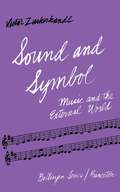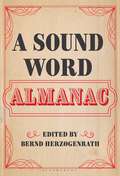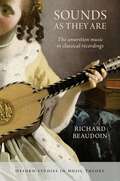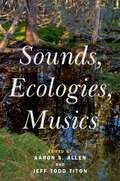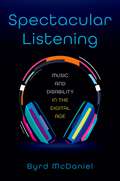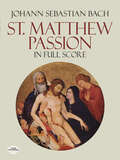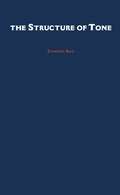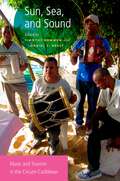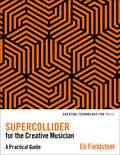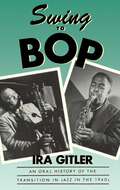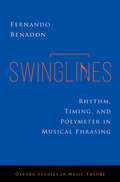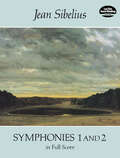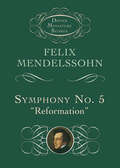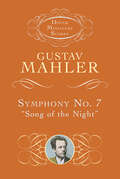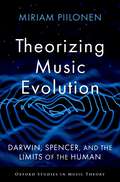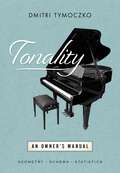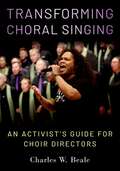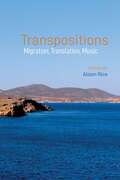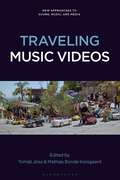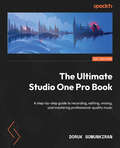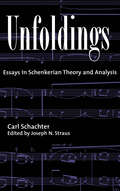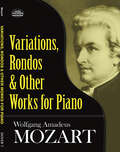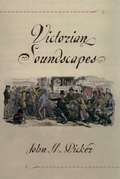- Table View
- List View
Sound and Symbol, Volume 1: Music and the External World
by Victor Zuckerkandl Willard R. TraskAn approach to music as an instrument of philosophical inquiry, seeking not so much a philosophy of music as a philosophy through music.
A Sound Word Almanac
This almanac of sound words important to artists and scholars highlights words that expand the way we speak (and write) about sonic experiences.Why write about sound, and how? If sonic philosophy is the attempt "to think about sound by philosophical means," then a metaphilosophical debate appears almost immediately on the horizon: What is called for is an understanding about sound and language, but also about the preconditions of musical understanding. What is at stake is the question of language and sound, as well as expanding how we speak about sonic experience.This almanac tackles these questions from artistic, experimental and personal perspectives. An assemblage of nearly 70 practitioners and theoreticians, artists and scholars offer their favorite 'sound word.' These sound words are onomatopoetical, mythological, practical; words of personal importance to the artists and their craft; words from their memory, related to sound. Many entries are not in English – some are untranslatable – and all are accompanied by a personal, explanatory, poetic entry. These are words that have the potential to change our perspective on listening-musicking-thinking.
Sounds as They Are: The unwritten music in classical recordings (Oxford Studies in Music Theory)
by Richard BeaudoinIn a recording, what sounds count as music? Sounds made by a musician's body--including inhales, finger taps, and grunts--have for decades been dismissed as extraneous noises. In Sounds as They Are: The unwritten music in classical recordings, author Richard Beaudoin pioneers a field of inquiry into non-notated sounds in recordings of classical music, recognizing often-overlooked sounds made by the bodies of performers and their recording equipment as music. Beaudoin classifies such sounds via inclusive track analysis (ITA), a bold new theory based on a comprehensive census of audible events on a given recording, and then codifies their musical function. He builds a typology across four large categories: sounds of breath (inhaling and exhaling), sounds of touch (guitar squeaks, piano pedals), sounds of effort (grunting and moaning), and surface noise (on early recording formats). Breaths are shown to be as complex and diverse as chords. Touch sounds create empathy with listeners. Effortful vocalizations reveal connections between music-making and sex. The measurement of surface noise reveals moments of synchronization with the meter of the recorded piece. He draws analogies between unwritten music and painting, photography, poetry, psychology, and government. The book's methodology is intertwined with the aesthetics and ethics of non-notated sounds: who is allowed to make them, and how they are received by listeners, critics, and scholars. Beaudoin uncovers insidious inequalities across music studies and the recording industry, including the silencing of body and breath sounds along lines of gender and race. Sounds as They Are demonstrates the expressive, interpretive, and embodied possibilities that emerge when all sounds are valued coequally and asks music theory to face a simple truth: that all sounds deserve recognition.
Sounds, Ecologies, Musics
Sounds, Ecologies, Musics poses exciting challenges and provides fresh opportunities for scholars, scientists, environmental activists, musicians, and listeners to consider music and sound from ecological standpoints. Authors in Part I examine the natural and built environment and how music and sound are woven into it, how the environment enables music and sound, and how the natural and cultural production of music and sound in turn impact the environment. In Part II, contributors consider music and sound in relation to ecological knowledges that appear to conflict with, yet may be viewed as complementary to, Western science: traditional and Indigenous ecological and environmental knowledges. Part III features multidisciplinary and interdisciplinary approaches by scholars, scientists, and practitioners who probe the ecological imaginary regarding the complex ideas and contested keywords that characterize ecomusicology: sound, music, culture, society, environment, and nature. A common theme across the book is the idea of diverse ecologies. Once confined to the natural sciences, the word "ecology" is common today in the social sciences, humanities, and arts - yet its diverse uses have become imprecise and confusing. Engaging the conflicting and complementary meanings of "ecology" requires embracing a both/and approach. Diverse ecologies are illustrated in the methodological, terminological, and topical variety of the chapters as well as the contributors' choice of sources and their disciplinary backgrounds. In times of mounting human and planetary crises, Sounds, Ecologies, Musics challenges disciplinarity and broadens the interdisciplinary field of ecomusicologies. These theoretical and practical studies expand sonic, scholarly, and political activism from the diversity-equity-inclusion agenda of social justice to embrace the more diverse and inclusive agenda of ecocentric ecojustice.
Spectacular Listening: Music and Disability in the Digital Age
by Byrd McDanielImagine a powerful listening experience that you want to share with others. You could describe it to someone with words, or you may choose a flashier alternative. You could, for example, costume yourself and take to the stage in a famous concert venue, delivering a rousing air guitar interpretation of a beloved rock solo for a live audience. Maybe you seek something more subtle, so you pull out your smartphone and record yourself lip-syncing to a guilty pleasure, showing your followers how seamlessly the music fits your movements. Perhaps instead you want others to hear how the music makes you feel, which leads you to record a podcast episode that translates the thrill of listening into audible exclamations. In ways both mundane and sensational, listening can be an expressive act, enabling people to stage consumption as a public practice -- what author Byrd McDaniel calls "spectacular listening." Contemporary digital platforms not only support such activity but actively encourage people to package personal music reception into a performance that may be widely shared. With a range of compelling ethnographic case studies, McDaniel investigates a broad shift in contemporary listening norms and the stakes for listeners with disabilities. He reveals how listening-as-performance can be an opportunity for play, as well as a critical practice that exposes ableism in music institutions, technologies, and discourse.
Spectacular Listening: Music and Disability in the Digital Age
by Byrd McDanielImagine a powerful listening experience that you want to share with others. You could describe it to someone with words, or you may choose a flashier alternative. You could, for example, costume yourself and take to the stage in a famous concert venue, delivering a rousing air guitar interpretation of a beloved rock solo for a live audience. Maybe you seek something more subtle, so you pull out your smartphone and record yourself lip-syncing to a guilty pleasure, showing your followers how seamlessly the music fits your movements. Perhaps instead you want others to hear how the music makes you feel, which leads you to record a podcast episode that translates the thrill of listening into audible exclamations. In ways both mundane and sensational, listening can be an expressive act, enabling people to stage consumption as a public practice -- what author Byrd McDaniel calls "spectacular listening." Contemporary digital platforms not only support such activity but actively encourage people to package personal music reception into a performance that may be widely shared. With a range of compelling ethnographic case studies, McDaniel investigates a broad shift in contemporary listening norms and the stakes for listeners with disabilities. He reveals how listening-as-performance can be an opportunity for play, as well as a critical practice that exposes ableism in music institutions, technologies, and discourse.
St. Matthew Passion: In Full Score
by Johann Sebastian BachOne of the most performed and recorded of Bach's major works, the St. Matthew Passion has been a focal point of concert seasons and festivals around the world for over 150 years. First performed in the late 1720s, it is a drama of epic grandeur, long considered the noblest, most inspired musical treatment of the story of the crucifixion of Christ. Bach set the text, based on two chapters from the Gospel of St. Matthew, using a large ensemble of two choruses, soloists, and two orchestras. The full score is reprinted here from the fine edition prepared by the Bach-Gesellschaft.Although the St. Matthew Passion is often held to be the apotheosis of Lutheran church music, this magnificent oratorio reaches out to its audience in the language, form, and spirit of opera. Richly dramatic and theatrical, following the general form of Baroque opera, it unfolds its deeply moving story in recitatives, ariosos, arias, chorales, and mighty choral movements. This finely produced score offers music lovers the opportunity -- at a price far lower than comparable editions -- to follow performances score in hand, and to gain a more intimate knowledge of the rich musical textures of this great masterwork.
The Structure Of Tone
by Zhiming BaoThis book argues a fresh theory about the structure of tone. Bao investigates a wide range of tone sandhi data from various Chinese dialects and other Asian tone languages, providing empirical support for his proposal that tone is a formal entity which consists of register and contour. Bao establishes a clear typological distinction between register tone languages and contour tone languages whose contour tones have a more complex structure.
SuperCollider for the Creative Musician: A Practical Guide (Creating Technology for Music)
by Eli FieldsteelSuperCollider, an open-source, cross-platform software program for real-time sound synthesis and algorithmic composition, was created by James McCartney in 1996 and has evolved to become a powerful tool for music composition and research. Written by composer and sound artist Eli Fieldsteel, who has almost two decades' experience of using SuperCollider for a variety of creative audio projects, SuperCollider for the Creative Musician is a comprehensive tutorial and reference guide for students, composers, and practitioners seeking a structured educational tour through this unique and flexible software. The book begins with platform-specific fundamentals, explores a large family of creative techniques, and then guides the reader through the nuances of assembling, navigating, and performing large-scale projects. Key topics include synthesis, sampling, sequencing, signal processing, external control, and graphical user interface design. Written with both beginners and intermediate practitioners in mind, this book is an invaluable resource for sound creators whose background falls anywhere on the spectrum between musician and computer programmer, and who seek to add new and innovative code-based techniques to their skill set. The companion website has an extensive collection of detailed code examples, which can be downloaded for exploration, experimentation, and hands-on learning.
Swing To Bop: An Oral History Of The Transition In Jazz In The 1940s
by Ira GitlerThis indispensable book brings us face to face with some of the most memorable figures in jazz history and charts the rise and development of bop in the late 1930s and '40s. Ira Gitler interviewed more than 50 leading jazz figures, over a 10-year period, to preserve for posterity their recollections of the transition in jazz from the big band era to the modern jazz period. The musicians interviewed, including both the acclaimed and the unrecorded, tell in their own words how this renegade music emerged, why it was a turning point in American jazz, and how it influenced their own lives and work. Placing jazz in historical context, Gitler demonstrates how the mood of the nation in its post-Depression years, racial attitudes of the time, and World War II combined to shape the jazz of today.
Swinglines: Rhythm, Timing, and Polymeter in Musical Phrasing (OXFORD STUDIES IN MUSIC THEORY)
by Fernando BenadonThe way rhythm is taught in Western classrooms and music lessons is rooted in a centuries-old European approach that favors metric levels within a grand symmetrical grid. Swinglines encourages readers to experience rhythms, even gridded ones, as freewheeling affairs irrespective of the metric hierarchy. At its core, this book is a nuts-and-bolts study of durational comparisons in the context of creative expression. It shows that rhythms traditionally framed as "deviations" and "non-isochronous" have their own identities. They are coherent products of precise musical thought and action. Rather than situating them in the neither-here-nor-there, author Fernando Benadon takes a more inclusive view, one where isochrony and metric grids are shown as particular cases within the universe of musical time. Rhythms that do not readily comply with the metered regime are often regarded as anomalies and deformations. The music explored in this book demonstrates how readily this paradigm vanishes once the frame is flipped from what rhythm is not to what rhythm is. As conceptualized here, swing flattens the temporal field to consider how note values relate to one another by any magnitude, not just the simple ratios of traditional theory. Musical analyses illustrate the book's concepts with the aid of transcriptions and timing-data visualizations. Variation, tuplets, polymeter, displacement, phrase structure, rhythmic counterpoint, parallel tempos, cyclical patterns, and time signatures are shown to be particular expressions that draw their contours from the swing continuum. They showcase the rich diversity of rhythm and propose ways to reframe how we think about musical time.
Symphonies 1 and 2: In Full Score
by Jean SibeliusFinland's greatest composer and a major figure in the development of Scandinavian music, Jean Sibelius (1865-1957) is admired for his complete mastery of symphonic form. Of the seven symphonies he composed, each differs greatly from the others, for Sibelius rarely approached the symphonic "problem" the same way. Each work seems committed to the thoughts, feelings, and logic of the movement.Sibelius's first two symphonies remain among his most accessible and popular. Of all his symphonic works, perhaps the First Symphony, composed in 1898-99, adheres most to classical form yet reflects the spirit of Nordic nationalism that came to be associated with the composer's music.The Second Symphony, perhaps his most expansive and melodious work in symphonic form, demonstrates Sibelius's increasing command of orchestral form and scoring. These two major works are reprinted here from the definitive full-score editions published by Breitkopf & Härtel, Leipzig.
Symphony No. 5: "Reformation"
by Felix MendelssohnIn this staple of the orchestral repertoire, Mendelssohn interprets the Reformation in symphonic terms, building to a powerful series of variations on Martin Luther's confessional chorale, Ein feste Burg ist unser Gott (A Mighty Fortress Is Our God). This miniature score is reproduced from an authoritative edition, complete with numbered movements for easy reference. Affordable and compact, it is ideal for use in the classroom, at home, or in the concert hall.
Symphony No. 7: "Song of the Night"
by Gustav MahlerMahler's seventh symphony ranks among the composer's most popular and accessible works. Possessing neither a "program" nor a folk-song theme, it is a purely instrumental composition, both hopeful and romantic in mood, with a harmonic and stylistic structure that evokes the daily journey from dusk till dawn. This miniature score is reproduced from an authoritative edition, complete with numbered movements for easy reference. Affordable and compact, it is ideal for use in the classroom, at home, or in the concert hall.
Theorizing Music Evolution: Darwin, Spencer, and the Limits of the Human (Oxford Studies in Music Theory)
by Miriam PiilonenWhat did historical evolutionists such as Charles Darwin and Herbert Spencer have to say about music? What role did music play in their evolutionary theories? What were the values and limits of these evolutionist turns of thought, and in what ways have they endured in present-day music research? Theorizing Music Evolution: Darwin, Spencer, and the Limits of the Human is a critical examination of ideas about musical origins, emphasizing nineteenth-century theories of music in the evolutionist writings of Darwin and Spencer. Author Miriam Piilonen argues for the significance of this Victorian music-evolutionism in light of its ties to a recently revitalized subfield of evolutionary musicology. Taking an interdisciplinary approach to music theorizing, Piilonen explores how historical thinkers constructed music in evolutionist terms and argues for an updated understanding of music as an especially fraught area of evolutionary thought. In this book, Piilonen delves into how historical evolutionists, in particular Darwin and Spencer, developed and applied a concept of music that served as a boundary-drawing device, used to trace or obscure the conceptual borders between human and animal. She takes as primary texts the early evolutionary treatises that double as theoretical accounts of music's origins. For Darwin, music served as a kind of proto-language common to humans and animals alike; he heard the songs of birds and the chirps of mice as musical, as articulated in texts such as The Descent of Man (1871) and The Expression of the Emotions in Man and Animals (1872). Spencer, on the other hand, viewed music as a specifically human stage of evolutionary advance, beyond language acquisition, as outlined in his essay, "The Origin and Function of Music" (1857). These competing views established radically different perspectives on the origin and function of music in human cultural expression, while at the same time being mutually constitutive of one another. A ground-breaking contribution to music theory and histories of science, Theorizing Music Evolution turns to music evolution with an eye toward disrupting and intervening in these questions as they recur in the present.
Tonality: An Owner's Manual (OXFORD STUDIES IN MUSIC THEORY)
by Dmitri TymoczkoThis encyclopaedic book proposes a sweeping reformulation of the basic concepts of Western music theory, revealing simple structures underlying a wide range of practices from the Renaissance to contemporary pop. Its core innovation is a collection of simple geometrical models describing the implicit knowledge governing a broad range of music-making, much as the theory of grammar describes principles that tacitly guide our speaking and writing. Each of its central chapters re-examines a basic music-theoretical concept such as voice leading, repetition, nonharmonic tones, the origins of tonal harmony, the grammar of tonal harmony, modulation, and melody. These are flanked by two largely analytical chapters on rock harmony and Beethoven. Wide-ranging in scope, and with almost 700 musical examples from the Middle Ages to the present day, Tonality: An Owner's Manual weaves philosophy, mathematics, statistics, and computational analysis into a new and truly twenty-first century theory of music.
Transforming Choral Singing: An Activist's Guide for Choir Directors
by Charles W. BealeChoral conductors and clinicians often focus on honing the technical and artistic elements of their choir's performance, but what is the true purpose of choral singing? Choral performances sound beautiful, but they also tell stories, "say something" to someone, and create change in them. In that fundamental sense, they are always activist. In Transforming Choral Singing: An Activist's Guide for Choir Directors, author Charles W. Beale draws from his nearly 20 years of leading major choirs in the LGBTQIA+ choral movement internationally as well as his long experience as a singer, organist, conductor, and educator to put forth a new vision for choral singing: to move audiences and change the world. Four main principles underpin this vision: connection, impact, social justice, and stylistic openness. Beale lays down a non-canonical and inclusive framework, grounded in critical musicology and pedagogy, for mission-driven and activist-oriented engagement with the choral arts, and provides practical takeaways for choral practitioners and conductors through a lively mix of practical, rigorous, and fun workshops, tips, and suggestions. Starting from the premise that all styles deserve equal space, the nine chapters cover the core aspects of choral directing, including mission, vocal sound, rhythm and groove, improvising, programming, conducting, and leading a choral community, teaching and learning, and the daily practice of equity and inclusion. The book closes with a series of calls to action and lays out a potentially transformative activist vision for the whole field, which foregrounds participation and engagement, and conceives of all choral singing as a powerful catalyst for musical and social change. The result is a provocative and contemporary approach to building choral communities with profound implications for why we sing, what we sing, how we sing, and how we conduct, teach, rehearse, and lead a choral community.
Transpositions: Migration, Translation, Music (Contemporary French and Francophone Cultures #79)
This publication benefited from the support of the Institute for Scholarship in the Liberal Arts at the University of Notre Dame.This collective volume concentrates on the concept of transposition, exploring its potential as a lens through which to examine recent Francophone literary, cinematic, theatrical, musical, and artistic creations that reveal multilingual and multicultural realities. The chapters are composed by leading scholars in French and Francophone Studies who engage in interdisciplinary reflections on the ways transcontinental movement has influenced diverse genres. It begins with the premise that an attentiveness to migration has inspired writers, artists, filmmakers, playwrights and musicians to engage in new forms of translation in their work. Their own diverse backgrounds combine with their awareness of the itineraries of others to have an impact on the innovative languages that emerge in their creative production. These contemporary figures realize that migratory actualities must be transposed into different linguistic and cultural contexts in order to be legible and audible, in order to be perceptible—either for the reader, the listener, or the viewer. The novels, films, plays, works of art and musical pieces that exemplify such transpositions adopt inventive elements that push the limits of formal composition in French. This work is therefore often inspiring as it points in evocative ways toward fluid influences and a plurality of interactions that render impossible any static conception of being or belonging.
Traveling Music Videos (New Approaches to Sound, Music, and Media)
Traveling Music Videos offers a new interdisciplinary perspective on how contemporary music videos travel across, shape, and transform various media, online platforms, art institutions, and cultural industries worldwide. With the onset of digital technologies and the proliferation of global video-sharing websites at the beginning of the 21st century, music video migrated from TV screens to turn instead to the internet, galleries, concert stages, and social media. As a result, its aesthetics, technological groundings, and politics have been radically transformed. From the kinaesthetic experience of TikTok to the recent reimaginations of maps and navigation tools through music video cartographies, from the ecofeminist voices mediated by live-stream concerts to the transmedia logic of video games and VR, from the videos' role in contemporary art galleries to their political interventions -the chapters map the ways music video is continually reconfiguring itself. The volume tracks music video's audiovisual itineraries across different geographies, maps its transmedia routes, and tackles the cultural impact that it has on our current media ecosystem.
The Ultimate Studio One Pro Book: A Step-by-step Guide To Recording, Editing, Mixing, And Mastering Professional-quality Music
by Doruk SomunkiranThe Ultimate Studio One Pro Book: A Step-by-step Guide To Recording, Editing, Mixing, And Mastering Professional-quality Music
by Doruk SomunkiranA step-by-step guide to recording, editing, mixing, and mastering professional-quality music
Variations, Rondos and Other Works for Piano
by Wolfgang Amadeus MozartThe elegance, grace, and clarity of Mozart's piano music has charmed generations of music lovers. Now 37 of the composer's delightful piano pieces have been collected in this attractive volume, reproduced from the authoritative Breitkopf & Härtel edition. Among the selections are:Variations on "Mio caro Andone" by Salieri, K.180/173cVariations on "Je suis Lindor" by Baudron, K. 354/299aVariations on "Ah vous dirai-je, maman," K. 265/300eVariations on "La belle françoise," K.353/300fVariations on "Salve tu, Domine" by Paisiello, K. 398/416eVariations on "Unser dummer Pöbel meint" by Gluck, K.455 Variations on a Minuet by Duport, K.573Rondo in D Major, K.485Rondo in A Minor, K.511Minuet in G Major, K.1/1eMinuet in F Major, K.2Minuet in D Major, K.355/576bAllegro in B-flat Major, K.3Allegro in B-flat Major, K.400/372aAllegro in G Minor, K.312/590dFugue in G Minor, K.401/3753Fugue in E-flat Major, K.153/375fFugue in G Minor, K.154/385kCapriccio in C Major, K.395/300gAllegro and Andante, K.533Adagio in B Minor, K.540Gigue in G Major, K.574... and more.
Victorian Soundscapes
by John M. PickerFar from the hushed restraint we associate with the Victorians, their world pulsated with sound. This book shows how, in more ways than one, Victorians were hearing things. The representations close listeners left of their soundscapes offered new meanings for silence, music, noise, voice, and echo that constitute an important part of the Victorian legacy to us today. In chronicling the shift from Romantic to modern configurations of sound and voice, Picker draws upon literary and scientific works to recapture the sense of aural discovery figures such as Babbage, Helmholtz, Freud, Bell, and Edison shared with the likes of Dickens, George Eliot, Tennyson, Stoker, and Conrad.
